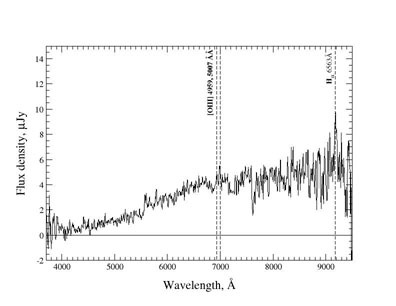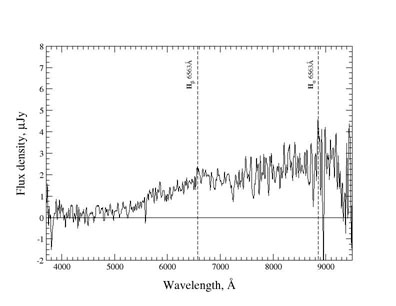
|
|

|
| Eng Rus |
|
|
Main Team Observational programs Results Publications Presentations at conferences Holding conferences: GRB mini-workshop 2006 GRB workshop 2009 |
THE HOST GALAXY OF GRB 001109Here we present the results of the spectroscopic and photometric observations of a probable host galaxy of GRB 001109. All the results we present were obtained with the SCORPIO instrument mounted at the 6-m telescope of SAO RAS.
V. Afanasiev, T. Fatkhullin, S. Dodonov, V. Sokolov, (SAO RAS), A. Castro-Tirado (IAA-CSIC Granada; LAEFF-INTA, Madrid), V. Komarova, A. Moiseev (SAO RAS), A. Cherepashchuk, K. Postnov (SAI-MSU Moscow) report: "On July 24, 2001 UT, we observed the field of GRB 001109 (Gandolfi, GCNs #878, #879). The photometric conditions were good with a seeing of about 1.3 arcsec. We have obtained three 180-s R-band images with the SCORPIO instrument (http://www.sao.ru/hq/moisav/scorpio/scorpio.html) at the 6-m telescope of SAO RAS. At the position of the VLA radiosource (Taylor et al. GCN #880) which is presumably a radio afteglow (Rol et al. GCN #889) we detected an extended object as already reported by Vreeswijk et al. (GCN #886) and Greiner et al. (GCN#887), most likely double. Spectroscopic observations (12 x 600-s exposures) were obtained with the 300 lines/mm grating giving a spectral resolution (FWHM) of about 20 A and an effective wavelength coverage of 3500 - 9500 A. The slit was placed along the extended object. The analysis revealed that the object is double with a spectra showing the continua with clearly detected Balmer break. The redshift for each component is: Object A: z = 0.398 +/- 0.002, based on identification of the Halfa 6563A, O[III] 4959,5007AA emission lines (brighter component) Object B: z = 0.3399 +/- 0.0005, based on identification of the Halfa 6563A, Hbeta 4861AA, emission lines (fainter component) If the radio transient is related to GRB 001109 indeed, then this is the nearest host galaxy detected so far. The R-band image can be seen at: http://www.sao.ru/hq/sokolov/hq/grb/HOSTS/GRB001109/GRB001109.html 

V. Sokolov, T. Fatkhullin, V. Komarova (SAO RAS) report: "Using the images obtained on July 24, 2001 (GCN #1090), we performed the astrometry to reveal where the VLA radiosource (Taylor et al. GCN #880; RA = 18h30m06.51s, DEC = 55d18'35.7", equinox J2000) has been placed. We used 10 USNO stars not saturated on the images and the astrometrical uncertainty is found to be about 0.5 arcsec, including statistic and systematic errors. The astrometry showed that radiosource is placed on the West outskirt of the brighter component A (GCN #1090). If the VLA radiosource is indeed located in this galaxy and related to GRB 001109 than the redshift of the GRB event is 0.398 +/- 0.002 (see GCN #1090). The image can be seen at http://www.sao.ru/hq/sokolov/hq/grb/HOSTS/GRB001109/GRB001109.html This message can be cited". |
| Design © ts@sao.ru | |
| Last update: 15.02.2014 | |